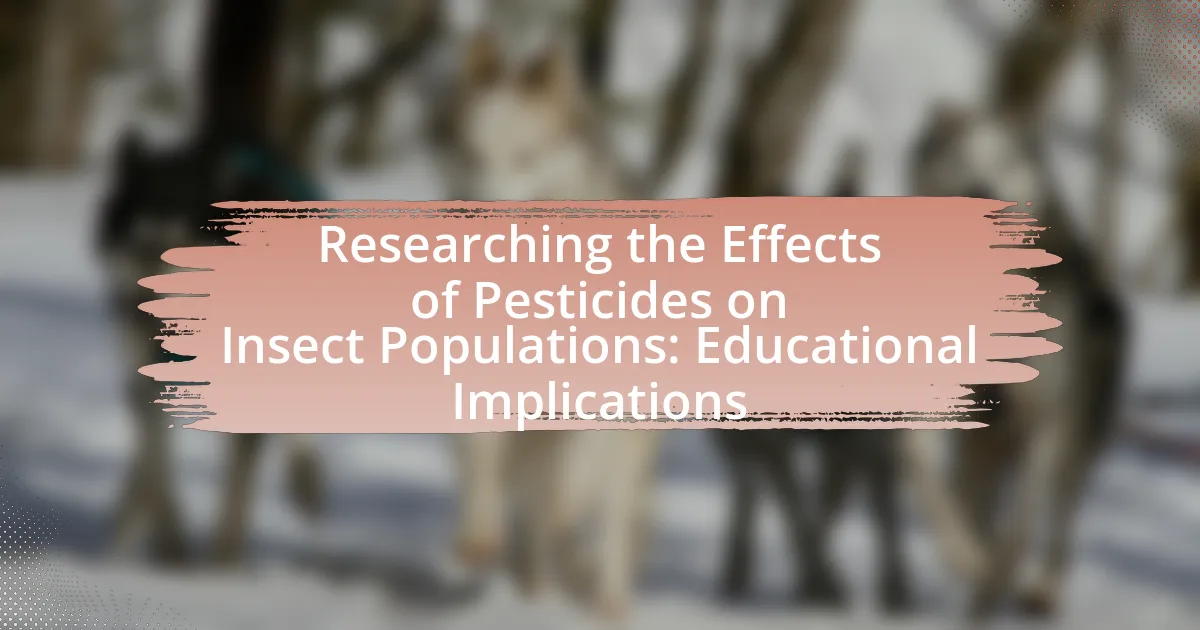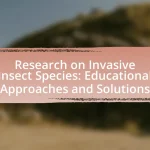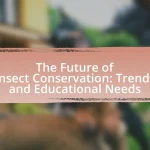The article examines the effects of pesticides on insect populations, highlighting their significant impact on biodiversity and ecological balance. It details how pesticides, particularly neonicotinoids, lead to direct mortality and reproductive disruption in various insect species, including bees and butterflies, resulting in population declines and altered food webs. The article also emphasizes the importance of studying these effects for informing educational curricula and promoting sustainable agricultural practices, while discussing methodologies used in research and the implications for environmental education. Overall, it underscores the critical role insects play in ecosystems and the necessity of understanding pesticide impacts for future generations.
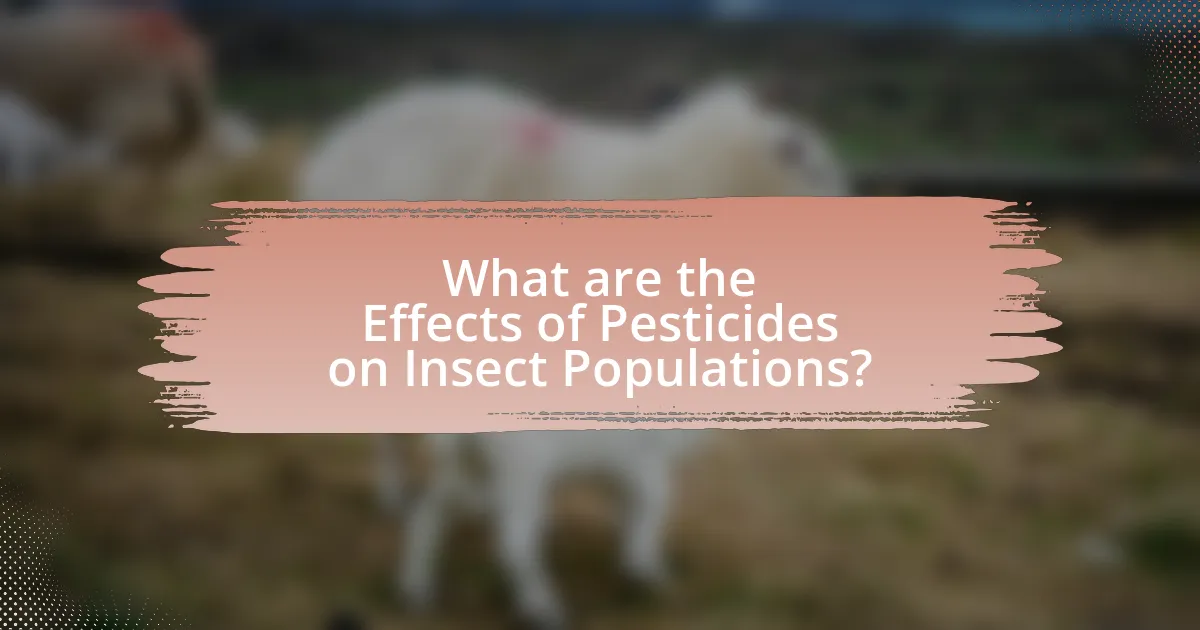
What are the Effects of Pesticides on Insect Populations?
Pesticides significantly reduce insect populations by causing direct mortality and disrupting reproductive processes. Studies have shown that exposure to pesticides can lead to acute toxicity, resulting in immediate death, as well as chronic effects that impair growth and reproduction. For instance, research published in the journal “Ecotoxicology” indicates that neonicotinoids, a class of pesticides, can decrease honeybee populations by up to 50% due to their impact on foraging behavior and colony health. Additionally, pesticides can alter the ecological balance by selectively targeting certain species, leading to a decline in biodiversity and the potential for pest resurgence.
How do pesticides impact insect diversity?
Pesticides significantly reduce insect diversity by causing direct mortality and sublethal effects on non-target species. Research indicates that the application of pesticides can lead to declines in both abundance and species richness among insect populations, disrupting ecological interactions and food webs. For instance, a study published in the journal “Nature” found that neonicotinoid pesticides were linked to a 50% decline in insect populations in treated areas compared to untreated ones, highlighting the detrimental impact on biodiversity.
What specific insect species are most affected by pesticides?
Bees, particularly honeybees (Apis mellifera) and bumblebees (Bombus spp.), are among the insect species most affected by pesticides. Studies have shown that neonicotinoids, a class of neurotoxic pesticides, significantly impair bee foraging behavior, reproduction, and overall colony health. Research published in the journal “Nature” by Goulson et al. (2015) highlights that exposure to these chemicals can lead to population declines in bee species, which are crucial for pollination and ecosystem balance. Additionally, other insects such as butterflies and certain beetles also experience detrimental effects from pesticide exposure, impacting their survival and reproductive success.
How do pesticide effects vary across different ecosystems?
Pesticide effects vary significantly across different ecosystems due to variations in biodiversity, soil composition, and water availability. In aquatic ecosystems, for instance, pesticides can lead to acute toxicity in fish and amphibians, disrupting reproductive systems and causing population declines, as evidenced by studies showing that certain herbicides can reduce fish populations by up to 50% in contaminated waters. In contrast, terrestrial ecosystems may experience different impacts; for example, pesticides can harm pollinator species like bees, leading to reduced pollination services, which are critical for many crops and wild plants. Research indicates that neonicotinoids, a class of pesticides, have been linked to a 30% decline in bee populations in agricultural areas. Furthermore, in forest ecosystems, the application of pesticides can disrupt the food web, affecting not only target pest species but also non-target organisms, including beneficial insects and soil microorganisms, which are essential for nutrient cycling. Thus, the ecological context plays a crucial role in determining the specific effects of pesticides, highlighting the need for ecosystem-specific management strategies.
Why is it important to study the effects of pesticides on insects?
Studying the effects of pesticides on insects is crucial for understanding ecological balance and biodiversity. Insects play vital roles in ecosystems, including pollination and nutrient cycling, and the application of pesticides can disrupt these functions. Research indicates that certain pesticides can lead to population declines in beneficial insect species, which can have cascading effects on food webs and agricultural productivity. For example, a study published in the journal “Nature” found that neonicotinoids, a class of pesticides, significantly reduce bee populations, which are essential for pollination. Understanding these effects helps inform regulatory policies and promotes sustainable agricultural practices that protect both insect populations and the ecosystems they support.
What role do insects play in ecological balance?
Insects play a crucial role in ecological balance by serving as pollinators, decomposers, and a food source for other organisms. Pollinators, such as bees and butterflies, facilitate the reproduction of flowering plants, which is essential for plant diversity and food production. Decomposers, including ants and beetles, break down organic matter, recycling nutrients back into the soil, which supports plant growth. Additionally, insects are a primary food source for many birds, mammals, and amphibians, contributing to the food web’s stability. The decline of insect populations due to pesticides can disrupt these functions, leading to negative consequences for ecosystems, as evidenced by studies showing that reduced insect diversity correlates with decreased plant pollination and nutrient cycling efficiency.
How can pesticide-induced changes in insect populations affect food webs?
Pesticide-induced changes in insect populations can significantly disrupt food webs by altering the availability of key species that serve as food sources for higher trophic levels. For instance, a decline in pollinator populations due to pesticide exposure can lead to reduced plant reproduction, which in turn affects herbivores that rely on those plants for sustenance. This cascading effect can ultimately diminish the populations of predators that depend on herbivores, thereby destabilizing the entire ecosystem. Research has shown that neonicotinoids, a class of pesticides, have been linked to declines in bee populations, which are crucial for pollination and maintaining plant diversity, further illustrating the interconnectedness of insect populations and food web dynamics.
What methodologies are used in researching pesticide effects on insects?
Researching pesticide effects on insects employs methodologies such as laboratory experiments, field studies, and modeling approaches. Laboratory experiments allow for controlled conditions to assess the direct impact of specific pesticides on insect physiology and behavior, often using bioassays to measure mortality rates and sub-lethal effects. Field studies provide real-world data by observing insect populations in their natural habitats, assessing the ecological consequences of pesticide application over time. Modeling approaches utilize statistical and computational techniques to predict the effects of pesticides on insect populations and ecosystems, integrating data from both laboratory and field studies. These methodologies collectively enhance understanding of pesticide impacts, supported by empirical evidence from numerous studies in entomology and environmental science.
What experimental designs are most effective for studying these effects?
Randomized controlled trials (RCTs) are the most effective experimental designs for studying the effects of pesticides on insect populations. RCTs allow researchers to randomly assign subjects to treatment and control groups, minimizing bias and ensuring that observed effects can be attributed to the pesticide treatment rather than other variables. This design has been validated in numerous studies, such as those published in the Journal of Economic Entomology, which demonstrate that RCTs provide robust data on the impact of pesticides on various insect species, allowing for accurate assessments of ecological consequences and educational implications.
How do researchers measure the impact of pesticides on insect populations?
Researchers measure the impact of pesticides on insect populations primarily through field studies, laboratory experiments, and population modeling. Field studies involve assessing insect diversity and abundance in areas treated with pesticides compared to untreated control sites, allowing for direct observation of pesticide effects in natural settings. Laboratory experiments provide controlled environments to evaluate specific pesticide toxicity levels on various insect species, often measuring mortality rates, reproductive success, and behavioral changes. Population modeling uses statistical methods to predict long-term effects of pesticide exposure on insect populations, incorporating data from both field and laboratory studies. These methods collectively provide a comprehensive understanding of how pesticides influence insect populations, supported by empirical data from numerous studies in entomology and ecology.
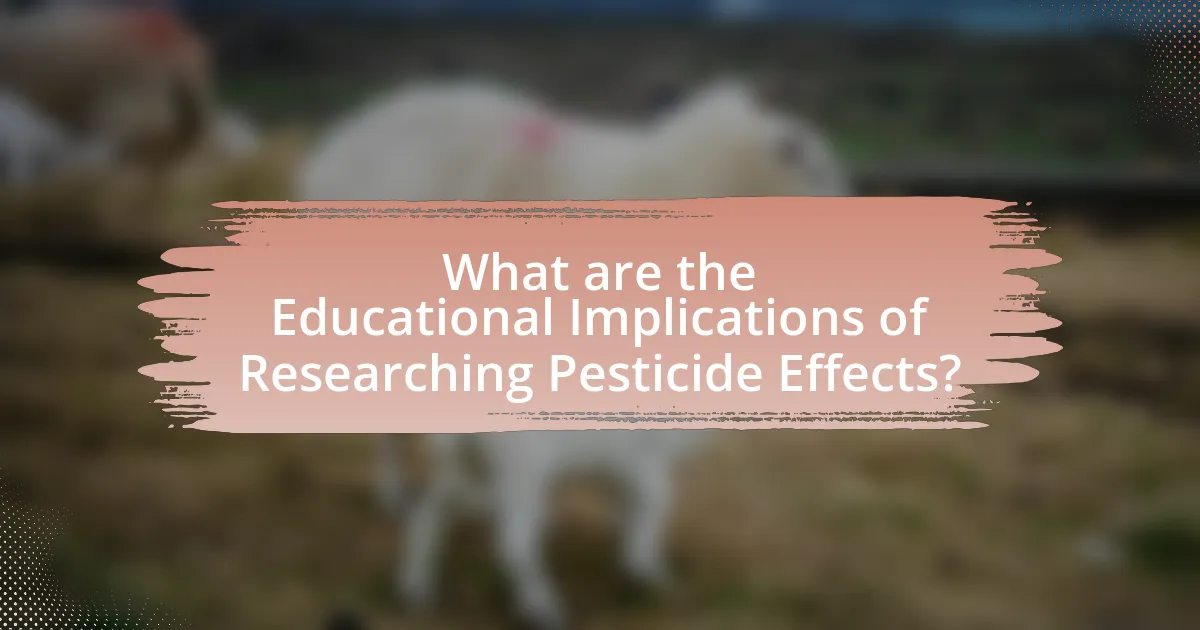
What are the Educational Implications of Researching Pesticide Effects?
Researching pesticide effects has significant educational implications, particularly in enhancing awareness of environmental science and sustainable practices. This research informs curricula by integrating real-world issues related to ecology, agriculture, and public health, fostering critical thinking among students. For instance, studies have shown that understanding the impact of pesticides on insect populations can lead to discussions about biodiversity and ecosystem balance, which are essential components of environmental education. Furthermore, educational programs can utilize findings from pesticide research to promote integrated pest management strategies, encouraging students to explore alternative agricultural practices that minimize chemical use.
How can findings from pesticide research inform educational curricula?
Findings from pesticide research can inform educational curricula by integrating evidence-based information about the impact of pesticides on insect populations into science education. This integration can enhance students’ understanding of ecological balance, biodiversity, and the consequences of human actions on the environment. For instance, studies have shown that certain pesticides significantly reduce pollinator populations, which are crucial for food production and ecosystem health. By incorporating such findings, curricula can promote critical thinking and environmental stewardship among students, preparing them to make informed decisions regarding agricultural practices and environmental conservation.
What topics should be included in environmental science education?
Environmental science education should include topics such as ecosystem dynamics, biodiversity, pollution, climate change, sustainable practices, and the impact of pesticides on insect populations. These subjects provide a comprehensive understanding of environmental systems and human interactions. For instance, studies have shown that pesticides significantly affect insect populations, which in turn impacts ecosystem health and agricultural productivity. Understanding these relationships is crucial for developing effective environmental policies and practices.
How can educators use real-world data to enhance learning?
Educators can use real-world data to enhance learning by integrating authentic datasets related to pesticides and insect populations into their curriculum. This approach allows students to analyze actual case studies, fostering critical thinking and problem-solving skills. For instance, by examining data from studies like “The Impact of Pesticides on Insect Biodiversity” published in the Journal of Environmental Science, educators can illustrate the real-life consequences of pesticide use on ecosystems. Such data-driven projects not only engage students but also help them understand the relevance of scientific inquiry in addressing environmental issues.
Why is it essential to educate future generations about pesticide impacts?
Educating future generations about pesticide impacts is essential to ensure informed decision-making regarding agricultural practices and environmental health. Knowledge of pesticide effects can lead to more sustainable farming methods, reducing harm to ecosystems and human health. For instance, studies have shown that pesticides can significantly reduce insect populations, which are crucial for pollination and maintaining biodiversity. According to research published in the journal “Nature,” insect populations have declined by 75% in some areas due to pesticide use, highlighting the urgent need for education on this issue. By understanding these impacts, future generations can advocate for policies that promote safer alternatives and protect ecological balance.
What skills do students gain from studying the effects of pesticides?
Students gain critical analytical skills from studying the effects of pesticides, enabling them to evaluate data and assess environmental impacts. This includes the ability to conduct experiments, interpret scientific literature, and apply statistical methods to analyze results. For instance, students learn to design studies that measure pesticide effects on insect populations, fostering skills in hypothesis testing and data collection. Additionally, they develop an understanding of ecological principles and the importance of biodiversity, which enhances their ability to think critically about environmental issues.
How can awareness of pesticide effects influence student behavior towards the environment?
Awareness of pesticide effects can significantly influence student behavior towards the environment by fostering a sense of responsibility and encouraging sustainable practices. When students understand the negative impacts of pesticides on ecosystems, such as the decline in beneficial insect populations and the disruption of food chains, they are more likely to advocate for environmentally friendly alternatives. Research indicates that educational programs highlighting these effects can lead to increased student engagement in environmental conservation efforts, such as participating in community gardens or promoting organic farming practices. For instance, a study published in the Journal of Environmental Education found that students exposed to information about pesticide impacts showed a 30% increase in pro-environmental behaviors compared to those who were not educated on the topic. This demonstrates that informed students are more likely to take action to protect their environment.
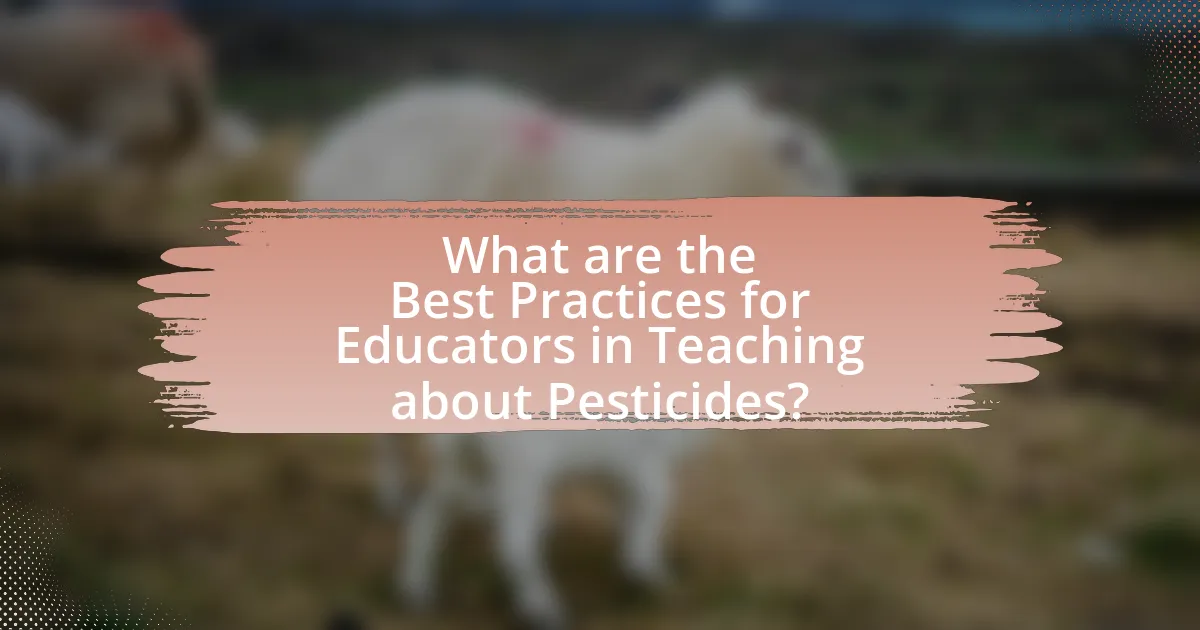
What are the Best Practices for Educators in Teaching about Pesticides?
The best practices for educators in teaching about pesticides include integrating hands-on activities, promoting critical thinking, and emphasizing safety and environmental impact. Educators should utilize real-world case studies to illustrate the effects of pesticides on insect populations, thereby fostering a deeper understanding of ecological balance. For instance, studies have shown that over 75% of pollinators are affected by pesticide exposure, highlighting the importance of responsible pesticide use. Additionally, incorporating discussions on alternative pest management strategies can empower students to consider sustainable practices. By engaging students in these ways, educators can effectively convey the complexities surrounding pesticide use and its implications for ecosystems.
How can educators effectively communicate the risks of pesticide use?
Educators can effectively communicate the risks of pesticide use by utilizing evidence-based information and engaging teaching methods. They should present data on the negative impacts of pesticides on human health and the environment, such as studies showing that certain pesticides are linked to neurological disorders in children and declines in pollinator populations. For instance, research published in the journal “Environmental Health Perspectives” indicates that exposure to organophosphate pesticides is associated with cognitive deficits in children. Additionally, educators can incorporate interactive activities, such as simulations or field studies, to illustrate the ecological consequences of pesticide application, thereby fostering a deeper understanding among students. By combining factual information with practical experiences, educators can enhance awareness and promote critical thinking regarding pesticide use.
What resources are available for teaching about pesticides and their effects?
Resources available for teaching about pesticides and their effects include educational websites, government publications, and academic research articles. Websites such as the Environmental Protection Agency (EPA) provide comprehensive information on pesticide regulations, safety, and environmental impact. Additionally, the National Pesticide Information Retrieval System (NPIRS) offers access to pesticide labels and safety data sheets. Academic research articles, such as those published in journals like “Environmental Entomology,” provide empirical studies on the effects of pesticides on insect populations, offering valuable insights for educators. These resources collectively support a well-rounded understanding of pesticides and their ecological implications.
How can educators engage students in discussions about sustainable practices?
Educators can engage students in discussions about sustainable practices by incorporating real-world examples and interactive activities that highlight the impact of human actions on the environment. For instance, discussing the effects of pesticides on insect populations can illustrate the broader implications of agricultural practices on ecosystems. Research shows that integrating hands-on projects, such as monitoring local insect populations or analyzing pesticide use in their community, fosters critical thinking and personal connection to sustainability issues. This approach not only enhances understanding but also encourages students to explore solutions, thereby deepening their engagement with sustainable practices.
What strategies can be implemented to foster critical thinking about pesticides?
To foster critical thinking about pesticides, educators can implement inquiry-based learning strategies that encourage students to ask questions, analyze data, and evaluate sources. For instance, engaging students in hands-on experiments that compare the effects of different pesticides on insect populations allows them to observe outcomes and draw conclusions based on empirical evidence. Research indicates that inquiry-based learning enhances critical thinking skills by promoting active engagement and reflection (National Research Council, 2000). Additionally, incorporating case studies that highlight real-world pesticide use and its ecological impacts can stimulate discussion and debate, further developing students’ analytical skills.
How can project-based learning enhance understanding of pesticide impacts?
Project-based learning enhances understanding of pesticide impacts by engaging students in hands-on research and real-world problem-solving related to pesticide use and its effects on insect populations. This approach allows students to investigate specific case studies, collect data, and analyze the ecological consequences of pesticides, fostering critical thinking and deeper comprehension. For instance, studies have shown that students involved in project-based learning demonstrate improved retention of knowledge and greater ability to apply concepts in practical scenarios, as evidenced by research conducted by Thomas Markham in “Project Based Learning Handbook” (2011), which highlights the effectiveness of experiential learning in science education.
What role do field studies play in educating students about pesticides?
Field studies play a crucial role in educating students about pesticides by providing hands-on experience and real-world context. These studies allow students to observe the effects of pesticides on insect populations directly, fostering a deeper understanding of ecological interactions and the consequences of pesticide use. Research indicates that experiential learning, such as field studies, enhances retention of information and critical thinking skills, making students more informed about environmental issues related to pesticides. For instance, a study published in the Journal of Environmental Education found that students who participated in field-based learning demonstrated a significant increase in their knowledge of ecological concepts compared to those who learned solely in a classroom setting.
